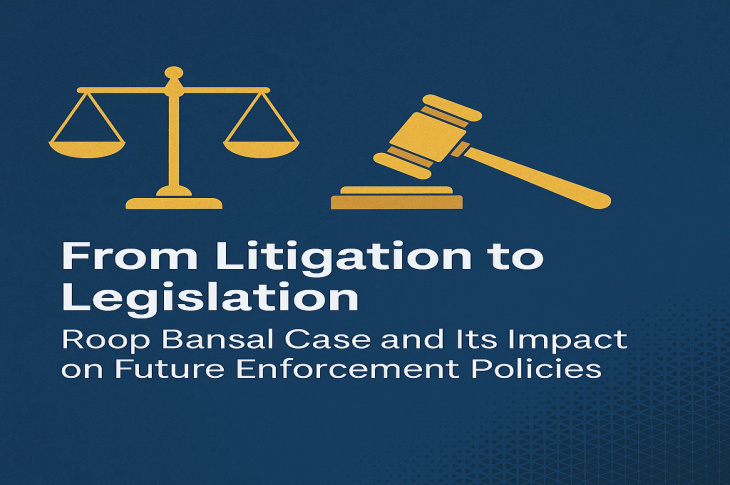From Litigation to Legislation: Roop Bansal Case and Its Impact on Future Enforcement Policies
Introduction
The relationship between law enforcement and economic growth has always been delicate in India’s fast-evolving commercial landscape. When powerful legal mechanisms like the Prevention of Money Laundering Act, 2002 (PMLA) intersect with industries that employ thousands, the stakes are enormous. A recent Supreme Court development involving Roop Bansal, a senior figure in M3M, a major real estate developer, has reignited debate on whether India’s enforcement framework should evolve beyond rigid asset freezes toward balanced solutions that also protect innocent stakeholders.
In July 2025, the Supreme Court allowed the substitution of provisionally attached properties—a decision that could reshape the way enforcement agencies act under PMLA. Although the order is case-specific and does not create binding precedent, it has raised critical policy questions. Could litigation like this pave the way for new legislation that balances robust enforcement with economic continuity? This blog examines the Roop Bansal case, explores its legal and economic context, and considers its long-term implications for India’s enforcement policies.
Background: PMLA and Its Enforcement Mandate
The Purpose of PMLA
The PMLA was enacted in 2002 to combat money laundering and confiscate assets derived from crime. Section 5 empowers the Enforcement Directorate (ED) to provisionally attach property suspected to be “proceeds of crime” even before trial or conviction. The idea is to prevent accused parties from dissipating assets before the law can act.
The Enforcement Dilemma
While pre-emptive attachment safeguards public funds, it can also halt legitimate commercial activity. Real estate projects, for instance, involve investments from homebuyers, banks, and contractors—many of whom have no connection to alleged offences. Freezing operational assets midstream can:
-
Leave homebuyers stranded without possession or refunds.
-
Put workers and vendors out of jobs.
-
Trigger defaults on loans, affecting financial institutions.
-
Reduce tax revenues for state governments.
The Roop Bansal matter exposes this tension between strict enforcement and economic stability.
The Roop Bansal Case: What Happened
Facts in Brief
-
The ED provisionally attached properties linked to M3M under suspicion of being connected to proceeds of crime.
-
Instead of contesting the attachment outright, Roop Bansal’s legal team proposed substitution—offering built-up commercial assets of equal value to the ED.
-
The Supreme Court accepted this substitution, ensuring enforcement interests were protected while allowing ongoing projects to continue.
Why It Matters
This is the first high-profile instance where asset substitution has been allowed at this scale. The Court’s reasoning was rooted in:
-
Protecting innocent third parties (homebuyers, employees).
-
Preserving economic activity that generates taxes and jobs.
-
Maintaining ED’s security interest against dissipation of alleged proceeds of crime.
Judicial Discretion as a Policy Catalyst
Silence in the Statute
The PMLA does not explicitly allow substitution of attached properties. Chapter III outlines attachment and adjudication procedures but remains silent on alternatives.
Inherent Powers of the Supreme Court
The Court relied on its inherent powers to balance enforcement objectives with public interest. By crafting a solution outside statutory text, it demonstrated how judicial discretion can catalyze policy innovation.
A Precedent for Discussion, Not for Courts Alone
While this order does not bind lower courts, it sets a persuasive example. Future litigants and policymakers may look to it as evidence that enforcement rigidity can be tempered when wider socio-economic consequences are at stake.
Economic Impact: Real Estate, Employment, and Public Interest
The Scale of M3M’s Operations
M3M’s projects reportedly created over 1 lakh jobs and affected 5 lakh stakeholders. A blanket freeze could have disrupted:
-
Home deliveries to thousands of buyers.
-
Livelihoods for construction workers.
-
State revenues from stamp duty and GST.
Ripple Effects on the Economy
Freezing operational assets in such cases could lead to:
-
Investor flight—both domestic and foreign.
-
Delayed infrastructure projects, increasing costs.
-
Loss of public trust in regulatory fairness.
The substitution approach preserved economic continuity without compromising enforcement.
Key Legal Questions Raised
Should Substitution Be Codified?
A statutory framework could formalize substitution, ensuring:
-
Clear guidelines on when and how substitution is permissible.
-
Transparency for all stakeholders.
-
Reduced litigation due to consistent procedures.
How to Assess Proportionality?
Policymakers must define proportionality standards:
-
Should the value of substituted assets exceed the original attachment by a buffer?
-
How to ensure liquidity and marketability of substituted assets?
Public Interest Considerations
Future enforcement policy might explicitly weigh public interest, especially for industries like real estate or infrastructure.
Comparative Perspective: Global Practices
Many jurisdictions allow alternative enforcement mechanisms:
-
United Kingdom: Courts may permit undertakings or charge replacements.
-
United States: Asset substitution is codified under specific statutes to prevent disruption of ongoing businesses.
-
Singapore: Authorities balance asset freezes with economic continuity in large-scale projects.
India’s move toward substitution could align its enforcement with international best practices.
Potential Legislative Pathways
Amendments to PMLA
Parliament could:
-
Add a new section explicitly permitting substitution under strict safeguards.
-
Define time limits for evaluating substitution proposals.
-
Mandate public interest impact assessments for large-scale attachments.
Guidelines for ED
Even without immediate legislative change, the Ministry of Finance or ED could issue operational guidelines. This would:
-
Provide certainty to businesses.
-
Reduce judicial workload by preventing repetitive litigation.
-
Protect innocent third parties.
Implications for Real Estate and Infrastructure
Boosting Investor Confidence
Clear rules on substitution can:
-
Encourage foreign direct investment.
-
Reassure domestic developers that genuine projects won’t be unnecessarily stalled.
Protecting Homebuyers and Workers
By preventing project stoppages, substitution safeguards:
-
Homebuyers’ investments.
-
Jobs and wages for workers.
-
Timely delivery of urban infrastructure.
Challenges and Criticisms
Risk of Abuse
Critics may argue that substitution could become a loophole for offenders to shield ill-gotten assets. Safeguards are crucial:
-
Rigorous valuation of substituted assets.
-
Independent verification by neutral experts.
-
Continuous monitoring of substituted property status.
Administrative Burden
The ED may face increased workload in evaluating and monitoring substituted assets. Adequate training and resources will be essential.
Broader Policy Implications
Balancing Enforcement and Economy
The case highlights the need for holistic policy design—one that deters crime but does not cripple economic engines.
A Template for Other Sectors
Beyond real estate, industries such as banking, telecom, and infrastructure could benefit from similar approaches when enforcement action risks widespread disruption.
The Role of Stakeholders
Judiciary
Courts can continue to fill legislative gaps where urgent economic interests are at stake.
Legislature
Lawmakers can use this case as a reference point to introduce amendments.
Businesses
Corporations must maintain robust compliance frameworks to minimize risk and demonstrate good faith during investigations.
Civil Society and Media
Public scrutiny ensures that flexibility in enforcement is not misused for favoritism or corruption.
Lessons for Compliance and Risk Management
Strengthening Internal Controls
Companies should:
-
Maintain transparent records.
-
Regularly audit financial transactions.
-
Develop contingency plans for enforcement actions.
Engaging Proactively with Regulators
Proactive communication with enforcement agencies can build trust and may open doors for negotiated solutions like substitution.
From Litigation to Legislation: The Road Ahead
The Roop Bansal case underscores a broader truth: litigation often drives legislative evolution. Similar to how landmark judgments in privacy or environmental law shaped India’s statutes, this matter could prompt Parliament to refine the PMLA framework.
Possible future developments include:
-
Introduction of a Substitution Clause within PMLA.
-
Creation of Public Interest Impact Reports for major attachments.
-
Establishment of special benches to expedite substitution matters.
Practical Takeaways for Legal Practitioners and Businesses
-
Lawyers: Stay updated on emerging substitution practices to advise clients effectively.
-
Developers: Maintain clean financial practices to qualify for relief measures like substitution.
-
Investors: Factor in enforcement flexibility when evaluating Indian markets.
-
Policy Analysts: Monitor similar cases for signals of upcoming legislative change.
Conclusion
The Roop Bansal case is more than a single dispute—it’s a turning point in how India may balance strict anti-money laundering enforcement with economic pragmatism. By recognizing the real-world consequences of asset freezes and exploring substitution mechanisms, the Supreme Court has opened the door to progressive legislative reform.
If lawmakers codify substitution under strict safeguards, India’s enforcement framework could become both robust and responsive, ensuring that justice is served without crippling legitimate enterprise or punishing innocent stakeholders. The journey from litigation to legislation is not new in Indian law—but in the context of economic enforcement, the Roop Bansal matter could be a landmark moment that reshapes the future of compliance, risk management, and business confidence in the country.
Frequently asked questions
What is the Roop Bansal case about?
What is the Roop Bansal case about?
The Roop Bansal case involves the Supreme Court allowing substitution of provisionally attached properties under the Prevention of Money Laundering Act (PMLA) to prevent economic disruption while safeguarding enforcement interests.
Why is asset substitution significant under PMLA?
Why is asset substitution significant under PMLA?
Asset substitution ensures enforcement security while allowing operational projects to continue, protecting homebuyers, workers, and the broader economy.
How could this case influence future enforcement policies?
How could this case influence future enforcement policies?
Lawmakers may codify asset substitution under PMLA or issue guidelines to balance strict enforcement with economic stability.
Does the Supreme Court ruling in Roop Bansal set a binding precedent?
Does the Supreme Court ruling in Roop Bansal set a binding precedent?
No. The decision is case-specific and not legally binding, but it provides persuasive guidance and may inspire future legislative changes.
What are the potential risks of codifying asset substitution?
What are the potential risks of codifying asset substitution?
Risks include potential misuse by offenders and added administrative burden on enforcement agencies. Strong safeguards and monitoring will be critical.
Trending
Frequently asked questions
What is the Roop Bansal case about?
What is the Roop Bansal case about?
The Roop Bansal case involves the Supreme Court allowing substitution of provisionally attached properties under the Prevention of Money Laundering Act (PMLA) to prevent economic disruption while safeguarding enforcement interests.
Why is asset substitution significant under PMLA?
Why is asset substitution significant under PMLA?
Asset substitution ensures enforcement security while allowing operational projects to continue, protecting homebuyers, workers, and the broader economy.
How could this case influence future enforcement policies?
How could this case influence future enforcement policies?
Lawmakers may codify asset substitution under PMLA or issue guidelines to balance strict enforcement with economic stability.
Does the Supreme Court ruling in Roop Bansal set a binding precedent?
Does the Supreme Court ruling in Roop Bansal set a binding precedent?
No. The decision is case-specific and not legally binding, but it provides persuasive guidance and may inspire future legislative changes.
What are the potential risks of codifying asset substitution?
What are the potential risks of codifying asset substitution?
Risks include potential misuse by offenders and added administrative burden on enforcement agencies. Strong safeguards and monitoring will be critical.



Ask a Lawyer